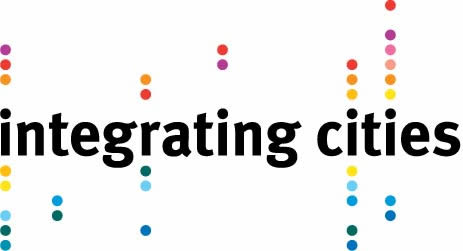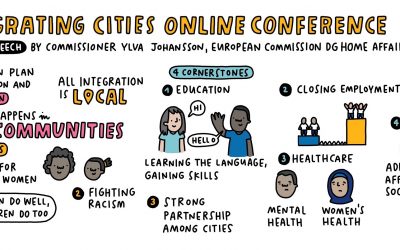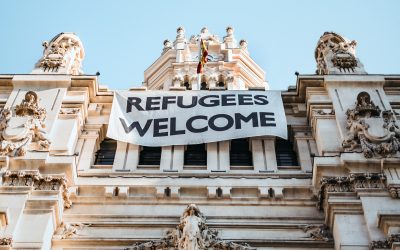Is the EUROCITIES Charter on Integrating Cities coming to Toronto? We asked two proponents to explain the need for a charter in a city celebrated for its diversity. Chris Brillinger is the City of Toronto’s Executive Director of Social Development, Finance and Administration, and Jehad Aliweiwi is the Executive Director of the Thorncliffe Neighbourhood Office, a multi service non-profit organization.
Why is a charter a good idea and what difference will it make?

Chris Brillinger: The City of Toronto was built on historical waves of immigrants coming into the city. We have seen newcomer settlement as an opportunity to enrich the city, economically, socially and culturally. More recently, we have seen some fundamental shifts in the class of immigrants coming into Canada which is a global phenomenon, shifting towards a greater acceptance and reliance on the economic class rather than those entering the country on humanitarian grounds. This has resulted in more temporary workers coming to Canada, and Toronto, rather than permanent residents. The development of a City Charter that reaffirms the rights of its residents and the obligations of a city seems timely given this shift. It is in keeping with the Toronto Newcomer Strategy adopted by Toronto City Council earlier this year, which speaks to the four strategic pillars – labour market participation, health of newcomers, access to services and civic engagement. The vision of the strategy is that “all newcomers reach their full potential to thrive and contribute to their local neighbourhood, community and city, ensuring Toronto’s continued success and prosperity.”
There is a growing recognition that the successful integration of newcomers in our city is critical for our success. We have to look at ways to be innovative about how we best facilitate that. While our influence over federal policies and legislation, which ultimately impact on who immigrates here, is limited, we have a great impact on the settlement experiences and integration of those who choose Toronto as their new homes. A charter would formally confirm our commitment to the successful integration of immigrants and would establish principles and priorities to guide the work and the approach of the City in meeting this commitment.

Jehad Aliweiwi: The City of Toronto is a wonderful example of a major city that recognizes its diversity as a source of strength and pride. However, Toronto is less embracing of its immigrant and refugee residents. Diversity and immigration, while related, are not the same thing. In addition, settlement is a local and mostly urban phenomenon. A document like the proposed charter will embed immigration and settlement into city planning and building process and more importantly, it will commit the city to specific actions with measurable, realistic and achievable objectives.
The recent adoption of the Toronto Newcomer Strategy is a positive step. The introduction of a charter that clearly establishes benchmarks to measure the city’s support for the civic and social integration of immigrant and refugees will enhance newcomer success and improve the city’s ability to utilize the skills and expertise they bring to our communities and neighbourhoods.
Should the Charter be adopted by Toronto City Council, what kind of accountability framework do you foresee?
Chris Brillinger: The City of Toronto is committed to accountable and transparent government. We are accountable to all Toronto’s residents and stakeholders. In the process of developing a Charter, we will be studying approaches to accountability that signatories of the EUROCITIES Charter have adopted. We know that cities across Europe have not implemented the charter in the same way, although their commitment to migrant integration is shared. It is great that we can learn from them and utilize what may work the best for our context.
An example may be the approach that Nantes took, where city council is held accountable to the Charter commitments by their Council of Foreign Residents. Nantes is a much smaller city, and it may not be feasible for us to have such a council, but we already have a Newcomer Leadership Table (NLT). This consists of the community-based sector, senior representatives from the Governments of Canada, Ontario and Toronto, and institutions such as school boards and hospitals. There are about 30 members. They meet quarterly to share information, strengthen interconnections and address gaps in the human services system related to the settlement of newcomers. In fact, the idea to develop a Charter similar to the one of EuroCities came from one of the NLT members.
Why this European model in particular and what difference will it make?
Jehad Aliweiwi: The more I learn about European cities’ commitment to integrating immigrants and refugees the more I believe Toronto can benefit from this model. The main appeal for this document is that it is simple, realistic and thorough. It focuses on the areas where the local government has full jurisdiction over. This frees the City from intergovernmental squabbles. This document will make a significant difference in changing the culture of municipal social and economic development planning. It will, hopefully, add a settlement dimension to all of its work. It would be remarkable to be able to subject all aspect of city building, planning and services to settlement and integration analysis.
What’s on your wish list for improved immigrant integration and a more inclusive Toronto?
Chris Brillinger: Two years ago, Toronto’s Local Immigration Partnerships and the Toronto Newcomer Initiative conducted extensive research and consultations with a range of stakeholders to identify priority areas for improved immigrant integration. Unfortunately, significant gaps and areas of improvement were identified. One of those is access to municipal supports. From the perspective of a senior manager, my wish list has to begin with that. Newcomers may not be well informed about City services, limiting their access to the programs and services we provide. This is a lost opportunity and is unnecessary. An inter-divisional work group is working on developing tools to improve access and streamline information on City services for both newcomers/immigrants and the settlement sector
Jehad Aliweiwi: The wish list is best described by “we imagine a city where immigrants come for the opportunity and stay to build a community.” Inclusive Toronto means immigrants and refugees are successful, connected and included. City policy and practices, like a charter on integration, can enable that. How does a general charter get adapted to the challenges of an individual city and its particular jurisdictional responsibilities?
Chris Brillinger: Such adaptation is a critical step, in particular in a city as complex as Toronto. There are not that many cities in the world where approximately half of its residents were born outside of the country and over 140 languages are spoken. This diversity creates an enormous potential, but also creates complexities for local service providers. For example, our diverse population needs to be reflected in the services we provide which creates resource demands that most other cities do not have. Adapting the charter in this context will challenge us to work more effectively with our key stakeholders such as the NLT to ensure transparency and inclusiveness and the successful implementation of our plan.
Jehad Aliweiwi: This will be a creative challenge for all of us. This will be an opportunity for us to learn more about our city. The charter needs to be Torontonized. It also needs to reflect the city’s past and aspirations for the 21st century. It has to reflect a robust city of the future that considers immigration as a source of economic growth, social vitality, cultural vibrancy and civic entrepreneurship.
How does a city translate aspirations into action? Is this akin to the relationship between policy and practice?
Chris Brillinger: Many cities around the globe are facing similar issues to us as far as immigration and integration of newcomers is concerned. Urbanization and globalization have created similar trends and issues across different regions, countries and continents, which provide opportunity to learn from national and international best practices. The Charter is one such opportunity and the signatories have already demonstrated a great deal of innovation when it comes to translating vision into action. Toronto has a great deal of experience in integrated approaches to social policy issues. We also take a neighbourhood or place-based approach in translating policy into meaningful action on the ground, in the neighbourhoods where newcomers reside.
Translating aspirations into action is always challenging, particularly with constrained resources. One of the objectives of the NLT is to identify opportunities to leverage existing investments to achieve better outcomes for newcomers. System change can have as significant an impact on the lives of newcomers, just as much as new investments.
Jehad Aliweiwi: The charter will include, in addition to the inspirational statement, a clear set of actions that the city needs to take in specific areas of jurisdictions. The City commits to simple and achievable outcomes that the council as a whole is held accountable for.
Which cities are using the Charter well?
Chris Brillinger: It may be too early to identify particular cities that are using the Charter well, considering that it was only introduced in 2010. Currently, there are 27 cities throughout Europe who are signatories. Each city is responsible for designing and implementing its own plan to meet its commitment to the charter. An implementation report published this year shows innovative and unique actions across signatory cities, which highlights how each city is using the charter well but in completely different ways. Some interesting activities across Europe include Barcelona’s public awareness campaign tackling rumours and stereotypes about immigrants, Helsinki’s procurement strategy, which includes social criteria and equality principles andCopenhagen’s establishment of a multi-sectoral Diversity Board to work towards the goal of becoming the “most open and inclusive major city in Europe.”
Jehad Aliweiwi: Berlin and a number of German cities are good examples of using the charter well. One of the things that we need to do is to learn where and how well the charter is being used. We should learn how cities like Berlin developed and implemented a document like this, what works and what doesn’t. We need to know the best examples of success in this area.
What is your favourite city and why?
Chris Brillinger: Toronto of course! Immigration and newcomers have always been core characteristics of our city. Toronto becomes richer and more complex with every wave of newcomers. The process of how newcomers settle and change once here and how they change Toronto is fascinating. There is much work to do to improve outcomes for newcomers. Equally there is much success to build on. “Diversity Our Strength” is the perfect City Motto!
Jehad Aliweiwi: I just came back from a three-week visit to Alexandria which was once the world most cosmopolitan cities. It’s a beautiful city by the Mediterranean with an unmatched boulevard along the seashore and a breathtaking library. Today there are only monuments and relics of its glorious and diverse past. Its once celebrated diversity can only be seen in the names of its streets like Lourane, buildings like St. Stefano and neighbourhoods like Stanley. One loves Alexandria for its glorious history but worries about its future. This is why Toronto is a city to whom, in many ways, the future belongs. Planning for a diversity and inclusion to be part of city building will endure that Toronto will never be a new Alexandria.
Chris Brillinger is the City of Toronto’s Executive Director of Social Development, Finance and Administration, and Jehad Aliweiwi is the Executive Director with the Thorncliffe Neighbourhood Office, a multi service non-profit organization.



